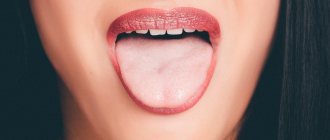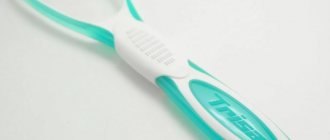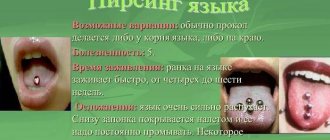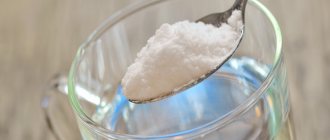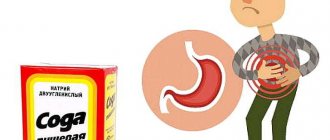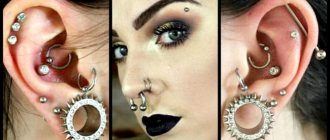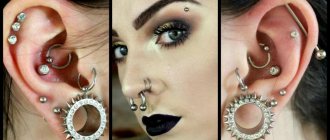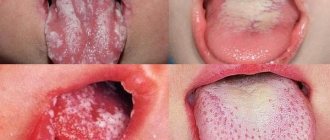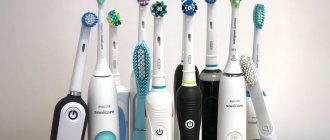- Why do you need to clean your tongue?
- How to clean your tongue
- How to clean your tongue
For many people, oral hygiene ends with brushing their teeth. However, cleaning your tongue is also necessary and important. Plaque and bacteria accumulate on it, from which caries develops and an unpleasant odor appears.
Regular tongue cleaning helps to avoid diseases such as stomatitis, gingivitis, caries and even periodontitis. Now we will look in detail at why you should clean your tongue and how to do it correctly and effectively.
Reasons for appearance
The healthy tongue of a physically healthy person should ideally be soft, soft pink, without cracks, abrasions or pimples. Sometimes there may be a slight grayish or brown coating on it, which is easily removed during hygiene procedures. If there is a thick layer of plaque on the tongue that cannot be removed by normal hygiene procedures, you should pay close attention to this. Most often, plaque on the tongue is formed due to digestive disorders:
- stomach diseases;
- gastritis;
- constipation;
- cholecystitis.
In the presence of these diseases, the patient develops a thick coating of white, gray or yellow color. Sometimes plaque is the first sign of a disease. In this case, the patient is interested in how to clean his tongue, but it turns out that he has serious diseases, without treatment of which it will not be possible to get rid of plaque. Therefore, the correct answer to the question: “I have a coating on my tongue, what should I do?” It would be advisable to consult a doctor and undergo a full examination for the presence of diseases of the gastrointestinal tract.
Dental removal techniques
These can be both primitive options and high-tech procedures. The choice of intervention method depends on the following factors:
- the patient's well-being;
- clinical picture (thickness, structure and density of the layer);
- age category;
- localization of formations.
It is acceptable to use several types in combination. They will serve as a supplement and speed up getting a positive result.
Ultrasound for removing solid deposits
How to remove plaque from teeth, from interdental spaces and other hard-to-reach places? The ultrasound method comes to the rescue. The waves crush the hardened layer, and then the broken off particles are washed away with water.
This method is suitable for cleaning both internal and external surfaces, areas between crowns. The structure of the incisors, canines and molars does not suffer from this procedure, however, if the patient has increased sensitivity, or there were too many layers, some discomfort may be felt for several days after visiting the dental office.
Laser removal
The laser beam removes the old stone absolutely painlessly by evaporating water into it. The tooth surface remains intact and is not damaged, the condition of the gums improves due to their tone. An additional advantage of the technique is its disinfecting (antibacterial) effect. There is also a drawback that may seem significant to some, but may not matter to others - it is high cost.
Manual removal
A classic option that has been used for decades. Hard deposits are torn off or scraped out with special devices - curette hooks.
This method in itself is traumatic, especially if the hardened layer has penetrated deep into the subgingival space. However, in some cases, this processing option is the only acceptable one due to certain contraindications and restrictions.
The patient may experience pain or other discomfort. To alleviate the condition, the doctor pre-treats the mucous membranes with a gel or anesthetic spray.
Chemical method
How will you clean your teeth from plaque in this case? The procedure can be used independently or in combination with others. More often, dentists choose the second option, and after chemical treatment they use laser, ultrasound or mechanical cleaning.
The essence of this technique is to apply a special gel-like composition with active ingredients (hydrochloric acid, hydrogen peroxide, etc.) to the surface of the enamel. A reaction occurs as a result of which the deposits are softened and washed away with water or removed manually using special tools.
Gentle Air-Flow sandblasting
Air-Flo is a method that is optimal in the presence of soft layers and a thin bacterial film. This way you cannot get rid of the hard stone.
During the procedure, the units are treated with a mixture of water, air, and special abrasives in powder form. The composition is supplied under a certain pressure.
Based on the results of medical manipulations, the overgrown layer is easily removed, without affecting the structure of the incisors, canines and molars, even if they are milk teeth. Patients who have chosen this technique note an undeniable advantage - the shade of the enamel becomes several tones lighter than before.
How to remove
If, after the examination, the doctor confirms that the patient does not have any disturbances in the functioning of the body, you can try to get rid of it yourself. We will tell you how to remove plaque on your tongue.
First of all, it is necessary to carefully monitor oral hygiene, because plaque formation is possible only when the patient does not brush his teeth systematically. When brushing your teeth, you should also brush your tongue, palate, and the inside of your cheeks. To do this, you can use either a regular toothbrush or a special toothbrush with silicone bristles applied to the back of the head to gently cleanse the tongue and cheeks.
During a visit to the dentist, do not hesitate to ask him how to clean plaque from your tongue. In principle, there is nothing complicated in this manipulation:
- after brushing your teeth with a brush with a small amount of toothpaste, gently, without pressing, in a circular motion, clean the surface of your tongue from accumulated plaque;
- The same circular movements should be used to clean the inner surface of the cheeks and the upper palate;
- For a more effective result, after brushing your teeth and tongue, the oral cavity must be rinsed with a special mouth rinse.
If these manipulations are carried out systematically, the coating on your tongue will not bother you.
How to prevent plaque formation?
As you know, the best treatment for diseases is their prevention. To prevent unaesthetic plaque on your teeth from bothering you and making you suffer in the dentist’s chair, remember a few rules that will help keep your teeth white, strong and smooth:
- Give up bad habits. No matter how trivial it may sound, it is smoking and alcohol abuse that are the strongest enemies of enamel. Put out the cigarette once and for all, minimize the consumption of wine, beer, vodka and other strong drinks, and within a couple of months you will notice that the condition of your teeth has noticeably improved.
- Review your diet . Coffee, soda, sweet juice and black tea are not at all safe for your teeth, even if you drink them through a straw. And caramels, toffees, cakes and chocolates not only leave an unpleasant coating on the enamel, but also provoke tooth decay. Include more fresh fruits, vegetables, and herbs in your diet - these are the foods that allow you to cleanse crowns naturally; in addition, plants strengthen the body.
- Don't write off sugar-free candies and chewing gum . These products activate salivation.
- Remember the rules of personal hygiene . Brushing your teeth twice a day is the key to healthy enamel, crowns, gums and nerves. Choose your toothpaste carefully, brush every square millimeter, be mindful of the space between your teeth, and be sure to remove the film from your tongue.
Effective and safe teeth whitening and cleansing of surface enamel stains is provided by Asepta Plus gentle whitening toothpaste. This paste has a unique multi-stage teeth cleaning system that guarantees whitening for 4 weeks without damaging the tooth enamel. Hydroxyapatite and potassium citrate, which are part of the paste, mineralize weakened tooth enamel, prevent the occurrence of increased tooth sensitivity, and calamus and eleutherococcus extracts strengthen the gums and accelerate the regeneration processes of the oral mucosa.
Treatment
Sometimes it happens that there seem to be no health problems, and plaque bothers you quite often. For this case, there are quite a few folk remedies. First of all, you need to accustom yourself to brushing your teeth and tongue after every meal, and if this is not possible, then you should at least rinse your mouth with clean water or a special balm-rinse. At home, you can rinse your mouth with decoctions of medicinal herbs such as calendula, chamomile or sage.
Propolis, honey and other bee products will help cure plaque on the tongue. They are excellent natural antiseptics, and since plaque is a bacterial substance, the antiseptic properties of propolis will be more useful than ever. For rinsing, you should use an alcohol tincture of propolis, a few drops of which should be dissolved in a glass of water.
And here is another recipe for how to get rid of plaque: if it is not possible to rinse your mouth after eating, you can simply chew a piece of propolis. It will not only clean the surface of the tongue, gums and teeth from food debris, but will also have an antiseptic effect on the oral cavity. True, this method is only suitable for those who are not allergic to bee products.
A good way to remove plaque from the tongue is to eat vegetables and fruits. On the one hand, solid pieces of vegetables and fruits mechanically clean the tongue, teeth and gums. On the other hand, their consumption improves the digestion process and helps eliminate the cause of plaque.
Is it possible to clean your tongue with a toothbrush?
You can remove the white film from the surface of your tongue with a toothbrush, either manual or electric. To remove plaque, use a toothbrush to move it from the base to the tip of your tongue.
There are other ways to remove physiological plaque without the help of a dentist.
- Special scrapers.
They are made of plastic and can be V-shaped or loop-shaped. They are very easy to use. It is enough to place them at the root of the tongue and slowly move it to the tip, removing the bacterial film. At the end of the procedure, you need to rinse your mouth with water or a special antibacterial product. Modern scrapers are designed to clean the surface of the tongue gently and delicately, without provoking a gag reflex or discomfort.
- Irrigators.
These devices care for the oral cavity using a directed stream of water. They clean interdental spaces, crowns and dentures, and also perfectly clean the surface of the tongue using a special attachment in the form of a spoon or spatula.
- Spoons.
If you don't have an irrigator, you can use a special spoon with rounded edges. You can easily find it in any pharmacy. The cleaning principle is the same - from base to tip with light pressure.
- Herbal rinses.
Decoctions of sage, calendula, and propolis help to cope with plaque. But they only complement the effect of mechanical cleaning and can be used for prevention.
White plaque
Quite often, a white coating on the tongue is accompanied by an unpleasant odor and may indicate problems with the gastrointestinal tract. You should conduct the following test: brush your teeth and tongue with a toothbrush and toothpaste and note the time until new plaque appears. If it forms on the tongue less than three hours after the hygiene procedure, it means that the cause of its occurrence is diseases of the gastrointestinal tract. If it formed much later, then this may be a variant of the norm. In this case, you should exclude smoked or fatty foods from your diet, as they stimulate plaque formation. It is better to give preference to boiled food and fresh vegetables and fruits.
Why plaque and stone are dangerous
The plaque that settles on the teeth is soft. It can be easily removed with any hygiene products. Within 6-12 hours it reacts with the components of saliva, becomes saturated with calcium salts and hardens. The only way to prevent this is to use mouthwash throughout the day. Once the plaque has hardened, it can no longer be removed.
Tartar gradually forms. It continues to grow as new layers of plaque easily “stick” to the rough surface. After about 6 months it becomes visually noticeable, but this is not its main danger.
The stone grows in the cervical part of the crown, gradually penetrating into the subgingival area. This leads to mechanical damage to the gums and loosening of the teeth. Microorganisms cause gum inflammation and provoke more severe oral diseases. Patients complain of bleeding and sensitivity of the gums, and bad breath. With further growth of the stone deeper into the gums, there is a risk of developing cysts on the root of the tooth.
Yellow plaque
A yellow coating on the tongue usually indicates digestive disorders. The following tips will help you:
- Carefully observe which foods cause a yellow coating on the tongue and eliminate them from your diet.
- Take Allohol tablets before meals to improve digestion.
- To normalize the functioning of the digestive system, take a decoction of flax seeds.
If the above measures do not help you, consult a gastroenterologist, he will tell you not only how to deal with plaque on the tongue, but also how to get rid of its root cause.
Why do you need to clean your tongue?
The benefits of tongue cleaning will be noticeable if the procedure is carried out regularly and correctly. Such care is especially important if there is a thick, dense coating of yellow, gray or brown color that has an unpleasant odor. These signs may indicate:
- infectious diseases - sore throat;
- fungal infections of the oral mucosa - candidiasis;
- pathologies of the digestive system;
- disorders of intestinal microflora;
- helminthic infestations;
- long-term use of certain medications;
- unbalanced diet;
- insufficient oral care.
Cleaning not only provides a fresh smell, but also gets rid of many pathogens. Its regular implementation allows you to get rid of tartar and other dental diseases. The procedure stimulates the functioning of internal organs and helps to better perceive the taste of food dishes.
Prevention
To prevent the formation of plaque on the tongue, one should systematically carry out oral hygiene procedures, cleaning not only the teeth and gums, but also the surface of the cheeks and tongue from plaque. It is also necessary to monitor your diet in order to prevent the occurrence of digestive disorders and to prevent the occurrence of diseases of the gastrointestinal tract. If a thick layer of plaque appears on the tongue that is difficult to remove, you should immediately consult a doctor and undergo an examination. If the root cause of the disease is not treated, it is impossible to eliminate plaque with cosmetic products.
Technique of the procedure
The benefits of tongue cleaning have been proven by doctors, and such manipulations cannot cause harm. However, this must be done correctly, otherwise no effect will be observed. You can purchase a special scraper, but a toothbrush is no less effective. Procedure:
- after cleaning the teeth, move on to the mucous membranes (start from the base and sweeping movements to reach the tip, do not press too hard);
- first treat one half of the organ, and then the other;
- move the bristles across several times (you can add a little paste);
- walk along the surface again, only in the opposite direction;
- rinse your mouth thoroughly.
Some people prefer traditional methods (propolis, baking soda). However, before turning to home medicine, it is recommended to consult a dentist.
How effective are traditional methods?
Some people don’t think about how to remove plaque from their teeth, remove it from their gums, and not harm themselves. In pursuit of a snow-white smile, methods are used, the use of which leads to more serious consequences. For example, many often turn to soda, salt, and activated carbon. All of these are abrasives. Dentists do not advise getting carried away with such cleansing options and carrying out the procedure frequently, since hard particles of different sizes scratch the enamel. As a result, it is gradually destroyed, the pathological process affects deeper layers, and caries occurs.
Traditional recipes show good results if the formations are soft. They cannot cope with stone: only a doctor can remove petrified structures.
